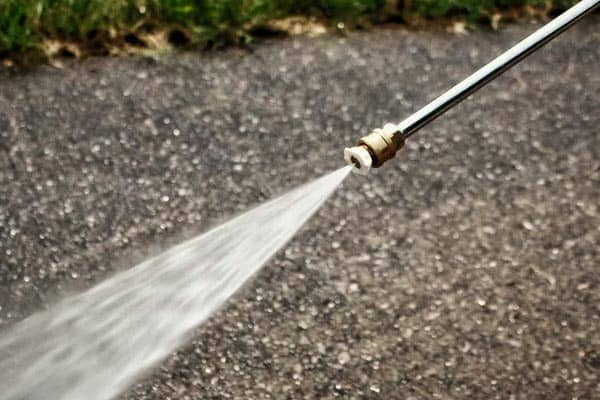How Long It Takes to Pressure Wash a Patio – Step-by-Step
Cleaning your patio can be a hassle, but pressure washing is the easiest way. This is especially true when you think of the layers of grime, dirt, and general buildup on your patio due to normal use and exposure to the elements.
The jet of water will cut right through it without any scrubbing on your end, making your patio look new.
How Long Does it Take to Pressure Wash a Patio?
It can take 30 minutes to two or three hours to pressure wash your patio, depending on how large it is, how much prep work you must do, how dirty it is, and how experienced you are with working with your pressure washer. If you have to pre-treat stains, this will add to your total project time.
Whether your patio is made from cement or wood, you can use the same techniques to clean it with a pressure washer. For tough stains, you might want to consult with professionals to ensure you remove them without damaging your patio. We’ll outline how to pressure wash your patio and much more below.
Safety Protocols for Pressure Washing Your Patio
When you use a pressure washer, you want to follow a few safety protocols to ensure that everyone stays safe for this project. You should:
Wear Safety Goggles—When you use a pressure washer, you should wear safety goggles because they can kick up small debris, like sticks or pebbles, that can hit you in the eyes. Wear goggles as a preventative measure to stay safe.
Safeguard Your Home—Before you start, safeguard your home by putting trash bags or plastic sheets over sensitive areas like doors or windows. You’ll want to protect your home from damage and your eyes during this project.
Set the Appropriate Pressure Level—Keep the pressure washer set to an appropriate PSI. Too much pressure can damage your patio’s surface, and you don’t want to crack or dent it.
How to Pressure Wash Your Patio – Five Steps
If you want to successfully and safely pressure wash your patio, follow the five steps below. This process works for wood or concrete surfaces.
1. Be Prepared and Plan Ahead
You want to have a plan when you decide to take on this project because the last thing you want to do is go in unprepared.
You should have the equipment you need to safely pressure wash a wooden patio deck on hand.
Most professionals recommend getting a pressure washer outfitted with a rotating tip or a nozzle with a wide fan tip.
Know that pressure washing can put enough force to etch brick, so you want to use the lower PSI settings to avoid damage and test on areas where people won’t see it when you first start.
2. Clear the Area
Before you start your pressure washing project, move all the furniture, such as tables, chairs, grills, and portable fire pits, out of the way. This will give you space to wash the patio without accidentally sending any furniture pieces flying.
Also, pressure washers can easily damage your patio or deck furniture if you hit them with the water jet, so moving them will help avoid damage or replace them.
3. Sweep Up Debris
In some locations, your patio gets exposed to the elements all year round, including wind, rain, sleet, and snow.
As the year progresses, leaves, sticks, debris, soil, and other contaminants will build upon your patio’s surface.
Before you pressure wash it, sweep up any loose debris so they don’t get hit with the water jet and turn into a projectile.
4. Start Pressure Washing
Once you sweep away all of the loose dirt and debris and move your patio furniture, it’s time to start pressure washing.
You may want to consider using a cleaner when you pressure wash to help get stains off the surface of your patio.
Pay special attention to ensure you remove grime and dirt from the cracks and grains of the patio’s surface because the contaminants can degrade these areas over time.
If you want to pressure wash a wooden patio, take steps to pressure wash along the grain instead of across it. This will reduce your chances of having splinters in the wood when you finish.
5. Rinse
When you finish pressure washing the patio, rinse the surface with clean water to remove any detergent or soap residue.
Any residue on your patio will get sticky as it dries, ensuring that it’ll attract more grime and dirt.
This will undo your pressure washing job, so you want to rinse it well and allow it to dry thoroughly.

Biggest Reasons to Pressure Wash Your Patio
People choose to pressure wash the patio for several reasons. We’ve picked out the three biggest reasons below.
Reason One – Less Labor-Intensive
If there is one daunting part of cleaning the patio, it’s the amount of labor required. Imagine how much effort you’d exert to scrub the patio with layers of caked-on dirt, mold, or hardened grime.
You’d be on your hands and knees for hours trying to scrub your patio, and it may not get clean enough for your tastes.
A pressure washer is a cleaning technique that relies on technology and a powerful jet of water over manual labor. You must stand and hold the wand for several minutes, but the water will do most of the work for you.
Reason Two – Saves Time
Cleaning the patio requires a commitment of time, and it will take more than a few minutes if you clean it manually.
Your patio has a lot of exposure to human-made and natural elements that can make them dirty daily.
The more you put off cleaning the patio, the more the grime, dirt, and mold will harden and be challenging to remove.
Using a pressure washer on your patio is always less time-consuming. The powerful water jet will blast the grime and dirt away in a few minutes.
3. Boosts Curb Appeal
A dirty patio can lower your home’s curb appeal, so power washing can help upgrade its value by making it look new.
Depending on its location, it’s one of the few areas potential guests see. So, pressure washing cleanses debris and dirt to make the entire property look nicer.
Bottom Line
You can pressure wash your patio in a few hours to remove years of caked-on grime and debris. This can boost your home’s curb appeal and allow you to enjoy a clean patio for years.
We’ve outlined the necessary steps to pressure wash your patio without damaging it, and you can try it out on your patio.






